How and what to process garlic before planting for the winter: rules for preparing planting material and useful tips
Farmers who invest efforts and resources in the preparation of garlic in the fall receive an early and rich harvest. The advantages of winter garlic (planted in autumn) are disease resistance, high yield, long-term storage.
From spring winter garlic is distinguished by a uniform arrangement of small cloves around the stem in the head. They have an even number - 6-10 pieces, a thicker shell, a pronounced pungent taste and are excellent for food and pickles.
Let's reveal the secrets of a bountiful harvest and tell you how to process garlic before planting for the winter.
The content of the article
Preparation of land for autumn planting of garlic
The first stage is the selection of a site for planting and soil preparation in the fall. Planting activities begin in early September. When choosing a place for a garden with garlic, we make sure that it is well lit and not in a draft.
So that when the snow melts in the garden, water does not accumulate and the garlic does not rot, we place the planting on a hill. Notice where snow falls first on your site, there is the highest place, and try to plant there.
If potatoes, carrots, turnips, onions or radishes have previously grown on the selected bed, this place is not suitable for planting garlicbecause they have the same pests. Better if it will be the beds after tomatoes, zucchini, legumes, cucumbers.
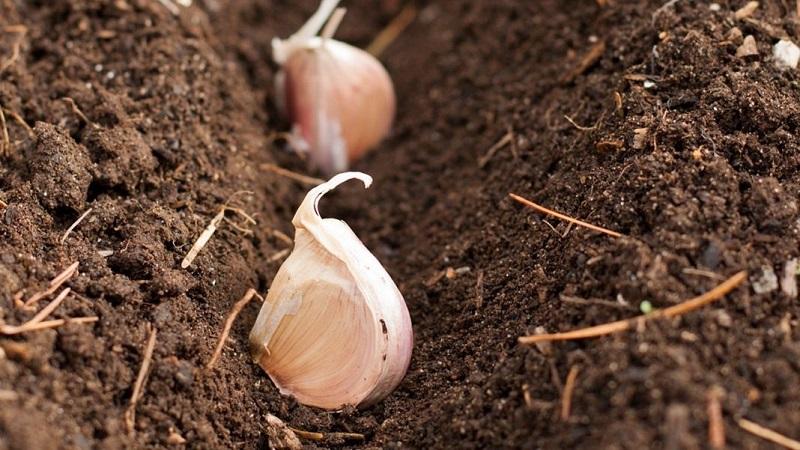 The soil should be loose and light, so we will first dig the garden to the depth of the shovel and fertilize. In case of lack of time, we buy ready-made fertilizers, but they are easy to prepare yourself. For example, let's feed with the following mixture: 45 g of the classic mineral dressing - nitrophosphate and 45 g of superphosphate, 250 g of dolomite flour, add this to a bucket of humus and fertilize the garden bed (calculated per square meter).
The soil should be loose and light, so we will first dig the garden to the depth of the shovel and fertilize. In case of lack of time, we buy ready-made fertilizers, but they are easy to prepare yourself. For example, let's feed with the following mixture: 45 g of the classic mineral dressing - nitrophosphate and 45 g of superphosphate, 250 g of dolomite flour, add this to a bucket of humus and fertilize the garden bed (calculated per square meter).
Council. Sprinkle wood ash between the rows of garlic, which will repel pests. The distance between the rows is 25 cm.
Be sure to determine the acidity of the soil. If nettles grow, coltsfoot, clover are signs of soil with normal acidity. Have noticed plantain or ivy - acidity is high. Garlic bears fruit well in soil with normal acidity, so if the readings are high, treat the soil with chalk or dolomite flour.
Garlic is planted to a depth of 12 cm, then covered with peat or sawdust, in extreme cases, dry leaves or pine needles.
The third stage is soil disinfection. This can be done in several ways:
- 5 g of manganese per 10 liters of water;
- 40 g of copper sulfate per 10 liters of water;
- 1 g of manganese, 1 g of boric acid, 1 g of copper sulfate per 1 liter of water.
After that, spill with calendula and yarrow tinctures, cover with foil and remove it just before planting.
Selection and preparation of seed
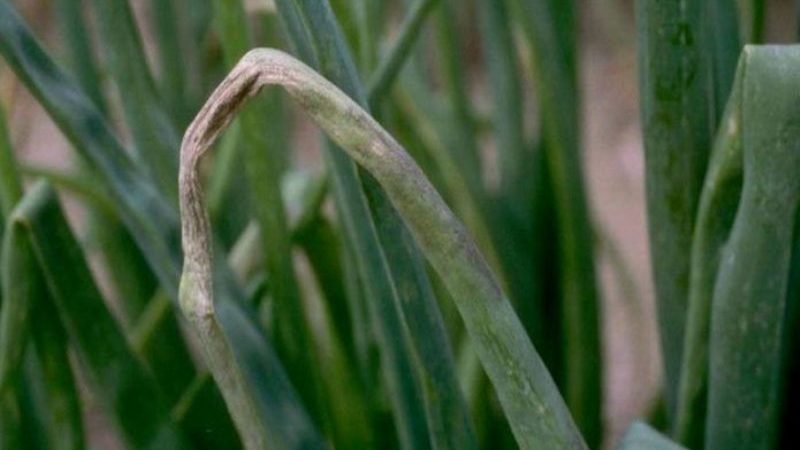
What kind of seeds you plant is also important. You can ideally select and prepare the soil, and the planting material will pump up. Then don't expect a harvest.
We pay attention to the following subtleties:
- We choose planting material large and dry, without damage, in a word, healthy. Please note that there should be scales on the teeth;
- when separating the teeth, make sure that the lower part is not damaged. The end of the clove should be dry and uniformly gray.
Processing garlic before planting
Before planting, processing of the planting material is mandatory. Garlic, despite the fact that it itself perfectly removes various viruses and bacteria, is very susceptible to various diseases. These are, for example, cervical or bacterial rot, downy mildew or downy mildew, garlic rust or garlic fusarium.
What diseases look like, look at the photo.
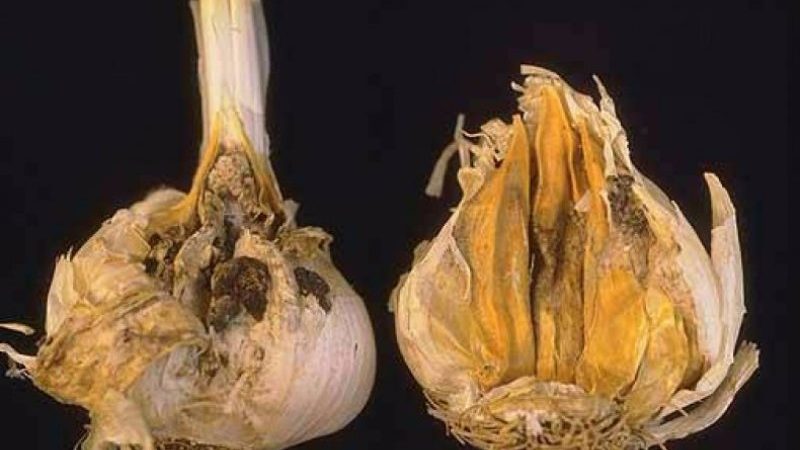
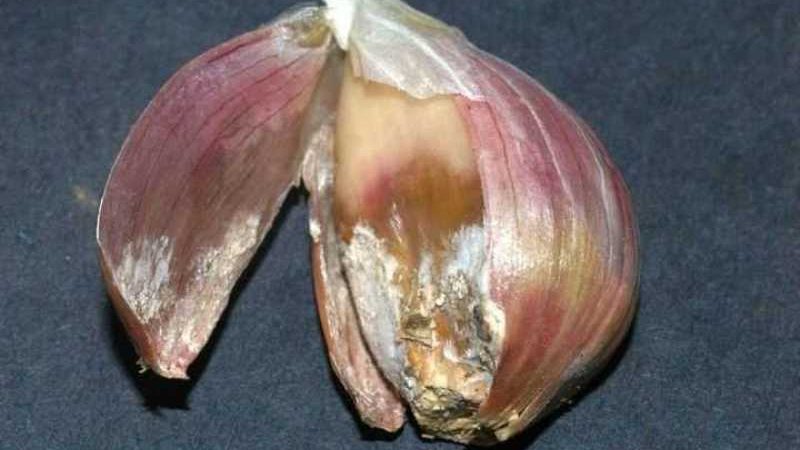
We get rid of potential pathogens before planting by properly processing the planting material.
For example, bacteriosis of garlic infects plants not only during growth, but also during storage. Bacterial rot is manifested by brown wounds on the lobules or the transparency of the clove. Garlic is exposed to disease if it is not ripe or has been poorly dried before storage, and possibly stored in a damp room. With such a disease, it is not enough to process only garlic; it is also necessary to cultivate the land.

How to process garlic
Let's take a closer look at how and how garlic is processed.
Brine
Solution: 2 tablespoons of salt in 1 liter of water.
Soaking time: half an hour.
Copper sulfate
Solution: 10 g vitriol in 1 liter of water.
Soaking time: 3-4 hours.
Potassium permanganate
Solution: a pair of manganese crystals in 5 liters of water.
Soaking time: overnight or 3-4 hours.
Ash liquor
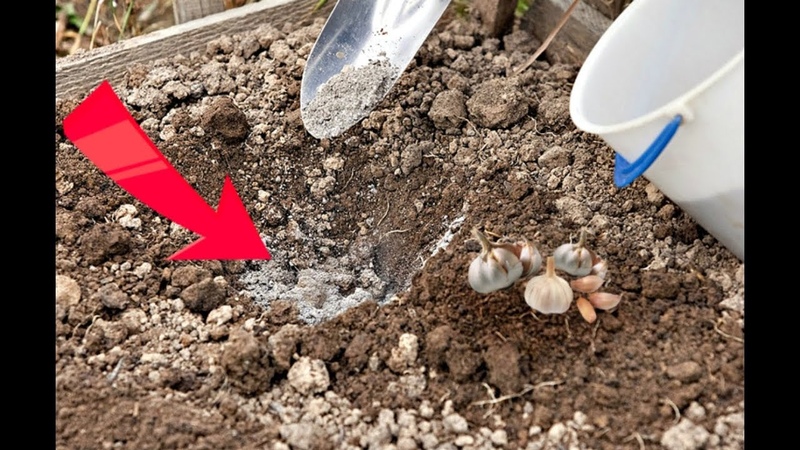
Lye is quite simple to prepare. We take ash from burning pine and birch firewood, corn and sunflower stalks, rye straw and buckwheat straw. Do not use ignition agents, as well as to burn plastic, cellophane and garbage in the same fire. The ash must be clean.
Solution: sift the ash and fill it with water after rain, melted or just boiled. Proportions: for 0.5 kg of ash, use 3 liters of water.
Then there are two ways:
- We insist 3-5 days, shaking regularly, after that we remove everything that floats on top and pour it into plastic bottles.
- We insist for 20-30 minutes, then heat it, practically bringing it to a boil (but do not boil it!). Let it cool completely, remove all excess from above and bottle the remaining cloudy liquid.
Store for about six months. Cannot be used in concentrated form. Dilute with water in a 1: 2 ratio.
We use it instead of a saline solution for disinfecting garlic before planting. We dilute the lye and soak the garlic in it for 1-2 hours.
Fungicide "Maxim"
The fungicide is not toxic to humans, it is the only agent of this class permitted for use in garden and summer cottages. It is odorless and mixes easily with water. Red pigment is added to the suspension, which allows you to control the application process.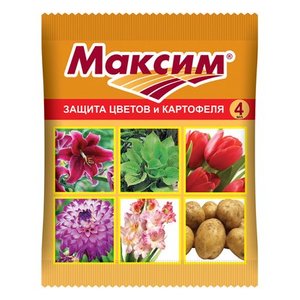
It is valid for 48 days after application, so you can process it at any convenient time.
It is also used to treat planting crops. Please note that the seed dressing cannot be used on germinated seeds or already infected seeds that have cracks. It does not heal, it prevents disease.
"Maxim" is prepared in glass or plastic containers. The term of use of the solution is a day after preparation.
Solution: 2 ml of the drug is mixed with 1 liter of water.
This is enough for 1 kg of garlic. The drug protects garlic from such forms of rot lesions as bottom, black, gray and penicillous.
Fitosporin
Fitosporin is sold in powder, liquid, and paste form. It is better to buy it in the form of a paste - it is more convenient and economical to breed. The powder is poorly soluble and cannot be stored, the liquid form is weaker in action.
Solution: take a bag of paste (200 g) and dilute in 400 ml of water. This is the so-called mother liquor. You can store it for a long time. When residues remain before winter, you can dilute them with water and water the compost pit or soil near trees and shrubs.
To soak the garlic, you need 0.2 g of the stock solution and 250 g of water. Soak for 0.5-1 hours.
If phytosporin is in powder form, then take ½ teaspoon and dilute in 1 liter of water and soak for 15 minutes.
Fundazol
"Fundazol" is a therapeutic and prophylactic drug, so the love of summer residents to it is fully justified. However, it is dangerous to humans, so it must be used in strict accordance with the instructions. It is produced in the form of a white powder with a smell.
Solution: for 10 g of powder 0.5 l of water.
Soaking time: for a day.
Tar
Birch tar is the most natural and safest remedy for humans and all living things. It is used to get rid of rot and onion flies.
Solution: add 1 teaspoon of tar to 1 liter of water.
Soaking time: literally half an hour before planting.
Can be repeated after germination of the garlic. Watering is not the seedlings themselves, but between the rows. The solution for irrigation is prepared from 10 liters of water, 1 tbsp. l. tar and 30 g of soap. After two weeks, repeat the treatment.
Dates and rules for disembarkation

Before winter, garlic begins to be planted 2-3 weeks before frost, so that before frost its root system has already developed, but there have been no shoots yet.
You can navigate by the temperature: when the average values are + 10 ... + 12 ° C, planting begins.
Roughly in the middle lane, this is the end of September-beginning of October. The farther south, the later they start, and vice versa.
Key points to look out for when landing:
- bed width - 1 m;
- the distance between the planted cloves of garlic is at least 10 cm;
- distance between rows - 20 cm;
- planting depth of garlic in autumn - from 8 to 12 cm;
- the cloves are planted with the bottom down;
- after planting, the ground is covered with peat, foliage, spruce branches, etc.
Useful Tips
A few tips from experienced summer residents:
- when buying garlic for planting, you can buy the wrong variety, so it is better to take planting material from friends on the recommendation or eventually withdraw your own;
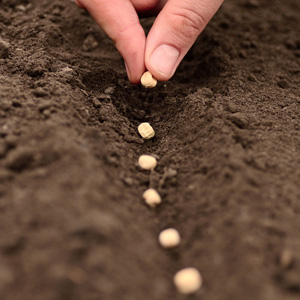
- do not plant garlic without scales, if it exfoliates itself, such a clove is more prone to rotting;
- do not plant garlic immediately after digging and preparing the beds for planting - let the earth settle down a little, and the fertilizers will take root;
- pay attention to the planting time: do not plant too early so that the garlic does not have time to sprout, because when the cold weather sets in, the planted garlic will die;
- in the spring, during the formation of the head of garlic, remove the arrows so that they do not take all the forces on themselves.
Conclusion
Each summer resident has his own rules and advice. Varieties, land, water and much more vary. Understanding the optimal growing technology comes from experience and personal observations. Some believe that garlic will succeed if planted before Pokrova, others are sure that yield does not depend on it. Someone covers the beds not with mulch, but with polyethylene or roofing material.
How to cultivate crops is a matter of your personal choice. Now manufacturers offer the richest selection of disinfectants. Try several types of solutions on the wedges at once, and then, when harvesting, you will conclude that it is applicable specifically to your type of land.
Be sure to write down the varieties that you plant, carefully observe their germination, recording the results. By analyzing yields and records, you will become an expert agronomist and yields will increase year after year.